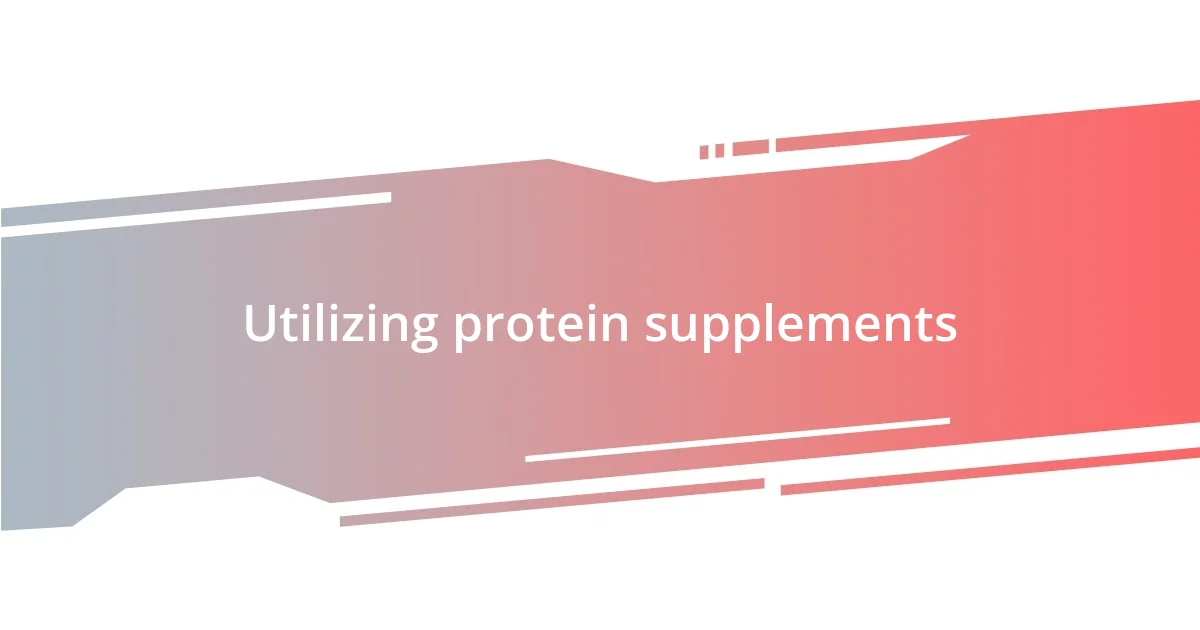Key takeaways:
- Protein is vital for muscle repair, energy levels, and overall health; increasing intake can lead to significant improvements in well-being.
- Setting realistic protein goals and tracking intake is essential, with gradual increases and personalized adjustments based on individual needs.
- Incorporating a variety of high-protein foods and supplements into meals can enhance energy levels, satisfaction, and dietary adherence.

Understanding protein importance
Protein is often called the building block of life, and for good reason. It plays a crucial role in repairing and building tissues, which is essential for anyone who exercises regularly or is recovering from an injury. I remember when I first realized how vital protein was for my body—after hitting a plateau in my strength training, I decided to tweak my diet and noticed significant progress just by increasing my protein intake.
Have you ever felt fatigued despite getting enough rest? It might be related to your protein levels. I experienced this firsthand. After incorporating more protein into my meals, I found that my energy levels improved dramatically. It’s fascinating how protein not only aids muscle recovery but also helps maintain energy and keeps you feeling fuller for longer.
Moreover, the importance of protein extends beyond just muscle health. It’s also key for hormone production, enzyme function, and even immune support. Each time I enjoy a protein-packed meal, I think about how those nutrients are working hard underneath the surface, contributing to my overall well-being. Isn’t it incredible to think that something as simple as a chicken breast or beans could be making such a profound impact on our health?

Setting protein intake goals
Setting protein intake goals can feel daunting, but I found that starting with clear, realistic targets made all the difference. Initially, I simply calculated my daily protein needs based on my weight and activity level. This straightforward method helped me create a solid foundation, and I could adjust as I progressed.
- Identify your protein requirements: Many experts suggest aiming for 0.8 to 1 gram of protein per kilogram of body weight, especially if you’re active.
- Set incremental goals: Just like any habit change, I didn’t attempt to jump from 50 grams to 150 grams overnight. I increased my intake by about 10-20 grams per week, which made the transition feel manageable.
- Track your intake: I used an app to monitor my daily protein consumption. This not only kept me accountable but also made me aware of where I could squeeze in extra protein, like adding Greek yogurt to my smoothies.
Another crucial aspect of setting goals is recognizing individual needs, which may vary based on lifestyle and fitness objectives. I remember feeling overwhelmed at first, comparing myself to others and their high intake goals. Eventually, I realized my body had its rhythm. Now, I focus on how I feel and adjust my goals accordingly, ensuring they align with my energy levels and overall wellness.

Choosing high-protein foods
When it comes to choosing high-protein foods, I’ve learned that variety is key. I often ask myself, “What can I add to my meals to boost my protein intake without feeling like I’m on a restrictive diet?” This inquiry leads me to incorporate a range of ingredients like lentils, eggs, and lean meats into my meals. I vividly remember a time when I replaced half the rice in my stir-fry with quinoa; the result was not just a protein boost, but a richer texture and flavor I absolutely loved.
Now, consider the nutritional profile of different high-protein foods. I find it helpful to read labels and compare options. For example, I initially overlooked plant-based proteins thinking they wouldn’t satisfy me, but after experimenting, I found that chickpeas and tofu can be just as filling and nutritious as chicken or fish. It’s amazing how much energy and satisfaction you can derive from foods like edamame or almonds, which I now snack on regularly.
To make this process even easier, I started creating a list of my favorite high-protein foods, pairing them with their protein content. This helps me ensure I’m meeting my daily goals. Take a look at the table below for a quick comparison of some common high-protein foods that might inspire your own meal prep!
| Food | Protein Content (per 100g) |
|---|---|
| Chicken Breast | 31g |
| Greek Yogurt | 10g |
| Tofu | 8g |
| Lentils (cooked) | 9g |
| Almonds | 21g |
| Chickpeas (cooked) | 9g |

Incorporating protein in meals
Incorporating protein into my meals has been a game-changer for my energy levels. I remember one weekend when I experimented with a protein-packed breakfast; I blended a banana with a scoop of protein powder, added Greek yogurt, and topped it with seeds. It filled me up for hours and set a positive tone for the day. Have you ever tried a breakfast shake that not only satisfies but energizes you?
I often find that simple swaps make a big difference. Instead of regular pasta, I’ve started using chickpea or lentil pasta in my dishes. The first time I tried it, I was skeptical, but to my surprise, it tasted just as delicious and gave my meal that extra protein boost I needed. Plus, it sparked a curiosity in me—what other ingredients can I replace to enhance my meals?
Now, when meal prepping, I make a conscious effort to add a source of protein to each dish, whether it’s throwing some grilled chicken over a salad or adding beans to my soups. It’s fascinating how a small change in approach can lead to enhanced satisfaction and fullness. What’s your favorite protein addition that transforms an ordinary meal into something extraordinary?

Utilizing protein supplements
Utilizing protein supplements has become a staple in my routine, especially on busy days. I remember the first time I mixed a scoop of whey protein into my morning oatmeal; it was like discovering a hidden treasure. Not only did it keep me full longer, but it also elevated the overall creaminess of my breakfast. Have you experienced a similar delight with your meals?
There are moments when whole foods just aren’t enough to hit my protein goals, and that’s when supplements come into play. I strategically use plant-based protein powders in my smoothies, which not only enhance their nutritional value but also add an interesting texture. It’s incredible how a simple addition can transform a drink into a well-rounded meal replacement. Isn’t it fun to think about all the flavors you can experiment with?
On days when I’m short on time, I keep ready-to-drink protein shakes in my fridge. These are my lifesavers! I can’t tell you how many times I’ve grabbed one after a workout, feeling utterly exhausted but satisfied that I’m still taking care of my nutrition. It’s amazing how convenience and health can go hand in hand when you find the right products. What do you think is the biggest advantage of incorporating protein supplements into your diet?

Tracking protein consumption
Keeping track of my protein consumption has been a revelation in my health journey. I started using a food diary app, and let me tell you, those first few days were eye-opening! I was astonished to see just how easily my protein intake could dip below my goals without me even realizing it. Have you ever counted your macros? It can really transform how you view your meals.
One trick that worked wonders for me was setting daily reminders to log my meals. This not only helped me keep an accurate tally but also served as a gentle nudge to incorporate more protein-rich foods into my diet. I remember a week when I was determined to hit my prescribed protein target; I felt so accomplished each time I ticked off a meal with ample protein. It’s fascinating to witness how a structured approach brings clarity and motivation to your dietary choices, wouldn’t you agree?
After a couple of months of tracking, I noticed patterns in my eating habits. For instance, I discovered that my weekends were usually protein-light due to impulsive snacking or skipping meals altogether. By recognizing this, I began planning weekend meals to ensure I met my goals, and it made a significant difference in my energy levels. Have you found specific times when your dietary choices are less than ideal? Identifying those moments can truly empower you to make positive changes.

Overcoming protein intake challenges
I’ve encountered several challenges when it comes to increasing my protein intake, especially on those days when I’m feeling overwhelmed. There was a period when I’d skip breakfast entirely, thinking I was saving time. Then I noticed how that habit impacted my energy and focus. Let me tell you, once I began prioritizing a protein-rich breakfast, I saw a dramatic improvement in my mood and productivity. Have you ever felt that shift in energy from just a simple meal change?
Another hurdle I’ve faced is the plethora of protein sources available, which can ironically make it confusing. I once stood in the grocery store, staring at numerous options without knowing what to choose. It was intimidating! So, I took the time to research the best types of proteins for my needs. I found that sticking to options I genuinely enjoy, like Greek yogurt and edamame, made a huge difference. What about you? How do you decide which protein sources to stick with?
And then there’s the social aspect. I can’t count the number of times friends have invited me out for meals at places with limited protein options. Initially, it felt like a setback. But I’ve learned to communicate my dietary needs to my friends. They’re often supportive and even interested in trying new, protein-rich dishes together. How do you navigate social situations when trying to hit your protein goals? Understanding that I can still enjoy my social life without compromising on nutrition has been liberating for me.















